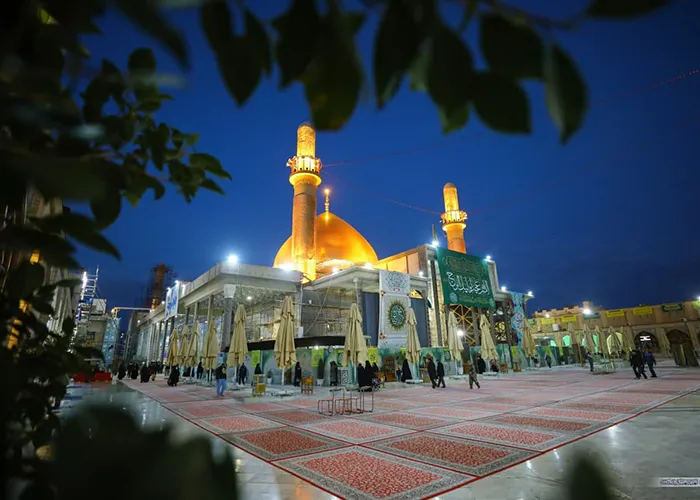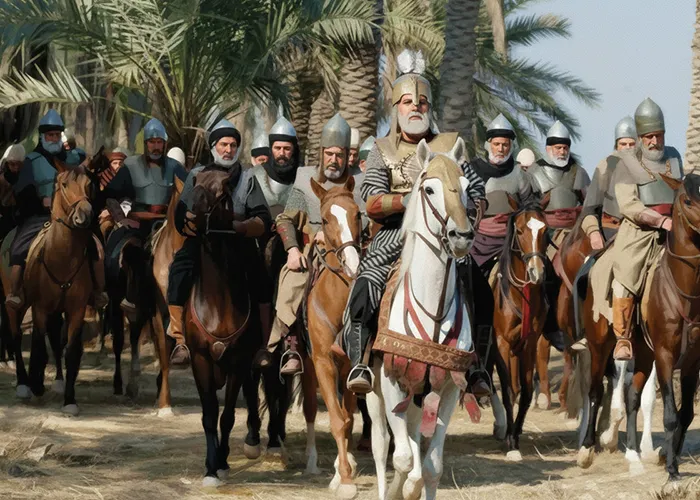Topic of the Week – Volume02 Issue34
The Passing of the Noble Prophet (P.B.U.H) and the Greatest Challenge of the Ummah: Caliphate or Imamate?
Seyed Hashem Moosavi
Introduction
The anniversary of the passing of the Noble Prophet, Muhammad (P.B.U.H), is not only a reminder of the profound grief felt by Muslims at the loss of the greatest messenger of God, but also an occasion to revisit his unparalleled legacy. Over twenty-three years of prophetic mission, he brought about a transformation in human society whose radiance continues to shine worldwide.
The demise of the Prophet (P.B.U.H) in the eleventh year after Hijrah marked a decisive turning point in the history of the young Muslim community. A society that had been built around the unique personality of the Messenger of Allah (P.B.U.H), and guided directly under his leadership, suddenly found itself facing an unprecedented vacuum in leadership and one of the most complex challenges to its political–religious identity.
Section One: A Pivotal Moment in History
The Fundamental Question After the Prophet’s (P.B.U.H) Passing
This monumental event brought a fundamental question to the forefront: How could the path of the Messenger of Allah (P.B.U.H) in leading the Ummah continue, and under what leadership model?
Moreover, was this leadership crisis truly an unexpected phenomenon, beyond the foresight of the Prophet (P.B.U.H)? Or had he, with divine insight, anticipated this challenge and provided a fundamental solution, such as appointing a successor?
This was not merely an administrative concern but a matter of faith and civilizational significance. In a society where its entire intellectual, moral, and political framework had been shaped under the Prophet’s direct guidance, his successor had to be a political administrator, a spiritual leader, and an infallible interpreter of divine revelation.
Examining this issue is key to understanding the decisive developments that followed his passing.
Section Two: Two Narratives, Two Paths
The Caliphate Model and the Imamate Model: Two Perspectives on Succession
In response to this pivotal question, two distinct and consequential interpretations emerged, shaping the future trajectory of the Islamic Ummah:
- The Saqifa School: Council and Allegiance for Political Unity
This perspective emphasised the pragmatic governance of society and the preservation of political unity through consultation (Shura) and allegiance (Bay’ah). Proponents of this view maintained that the Prophet (P.B.U.H) had not explicitly designated a successor. Thus, the Ummah was responsible for selecting the most qualified leader through collective consultation.
The event of Saqifa Bani Sa’ida, where Abu Bakr was chosen as the first Caliph, became the first manifestation of this approach.
- The Ahl al-Bayt School: Divine Appointment and Infallibility for the Continuity of Guidance
This school emphasised the continuation of the Prophet’s mission in guiding the religious and political life of the community through divine appointment and infallibility. According to this view, just as God chose the Prophet (P.B.U.H), his successor must likewise be designated through explicit divine decree. The Shia hold that the Prophet (P.B.U.H), on various occasions, most notably at Ghadīr Khumm, appointed Imam’ Ali (peace be upon him) as his Imam and successor.
A Fracture in the Unity of the Ummah
The clash between these two perspectives was not merely a theoretical or political disagreement; it created a deep rift in the governing structure of the Ummah. The absence of the Prophet (P.B.U.H) placed the community at a crossroads between “elective succession” and “divinely ordained Imamate”, a challenge that sparked a serious contest between the two approaches and led to the first schism within the body of the Muslim community.
Followers of the caliphate model focused on consolidating the fledgling political structure, even if that meant sidelining certain religious principles in the process. In contrast, adherents of the Imamate school prioritised safeguarding the authenticity of the faith and the correct interpretation of revelation, even if it meant distancing themselves from the centre of political power.
Here, to shed more light on the dimensions of the difference between these two approaches, a few historical examples and evidence from each of these two models of governance will be mentioned.
- Changes in Financial Policy and the System of Wealth Distribution (Caliphate Model)
The first departure from the Prophet’s (P.B.U.H) practice in the distribution of public funds (Bayt al-Māl) was the establishment of the Dīwān al-‘Aṭā’ by the Muslim caliph.[1]; a registry created to distribute spoils of war and state revenues according to individuals’ precedence in Islam. This contrasted sharply with the Prophet’s (P.B.U.H) method, in which spoils were divided equally among the believers. The justification for this policy shift was that such a system would help prevent tribal uprisings and facilitate the allegiance of the Arab elite. However, from an exegetical perspective, this action conflicted with verse 10 of Sūrat al-Ḥashr; «وَالَّذِینَ جَاءُوا مِن بَعْدِهِمْ…» “And those who came after them…” affirms believers’ equality. - Suspension of Certain Sharī‘ah Rulings During the Conquests (Caliphate Model)
The rapid territorial expansions during the era of the Rāshidūn caliphs and the necessity of administering vast lands inhabited by non-Muslim populations served as a justification for the suspension or alteration of specific Sharī‘ah rulings by the political authority governing the Muslim community. One example is the imposition of jizyah on the inhabitants of some conquered regions, such as Persia.[2], even though levying jizyah on Magians (Zoroastrians) contradicts the explicit text of the Qur’an, which, according to verse 29 of Sūrat al-Tawbah, restricts it to the People of the Book. - Imam’ Ali’s (P.B.U.H) Governance Conditional on the Establishment of Justice (Imamate Model)
In contrast to the first view, which considered it permissible to secure political authority even at the cost of altering religious teachings, Imam’ Ali (peace be upon him), as the head of the Imamate school, stresses in Nahj al-Balāghah that any rule over the people is worthless if it comes at the expense of truth and justice: «وَ اللَّهِ لَئِنْ أَبِیتُ عَلَى حَسَكِ السَّعْدَانِ… أَحَبُّ إِلَيَّ مِنْ أَنْ أَلْقَى اللَّهَ عَزَّ وَ جَلَّ وَ رَسُولَهُ يَوْمَ الْقِيَامَةِ ظَالِماً لِبَعْضِ الْعِبَادِ» “By Allah! If I were to spend the night upon the thorns of the sa’dān plant, it would be dearer to me than to meet Allah, the Almighty and Glorious, and His Messenger on the Day of Judgment, having wronged even a single servant.[3].”
Ibn Abī al-Ḥadīd (d. 656 AH), in his Sharḥ Nahj al-Balāghah (vol. 4, p. 107), writes:
“The Shī‘ah of ‘Ali (P.B.U.H) were always in a state of taqiyyah (precautionary dissimulation) and isolation, and the ruling powers would oppress them because they refused to justify the injustice of the rulers.”
Similarly, al-Jahshiyārī (d. 331 AH), another scholar from the Caliphate school, records in al-Wuzarā’ wa al-Kuttāb (p. 28) the confession of the Abbasid caliph al-Ma’mūn, acknowledging that the ‘Alawīs, due to their steadfast adherence to religious principles, never compromised with oppressors.
- The Uprising of Karbala: A Manifest Example of Preferring Martyrdom Over Allegiance to a Tyrant (Imamate Model)
When Imam Ḥussain (peace be upon him) was asked to pledge allegiance to the tyrannical ruler of his time, he replied: « إِنِّي لَا أَرَى الْمَوْتَ إِلَّا سَعَادَةً وَ الْحَيَاةَ مَعَ الظَّالِمِينَ إِلَّا بَرَماً. ؛ “Indeed, I see death as nothing but happiness, and life with oppressors as nothing but loathing.[4]”
In the modern era, scholars of the Ahl al-Bayt (peace be upon them) school have maintained that cooperation with any government must be conditional upon establishing justice. The creation of the institution of Marja’iyyah during the Occultation of the Awaited Imam (may Allah hasten his reappearance) was aimed at preserving a religious identity independent of state control. Likewise, the steadfast resistance of great scholars, such as Muḥaqqiq al-Narāqī against Fatḥ-‘Alī Shāh, and Imam Khomeini (R.A.) against the Pahlavi regime, demonstrates the primacy of faith over political power.
Section Three: Historical Consequences of the Dual Models of Governance in Islam
From Jamal and Ṣiffīn to the Formation of Islamic Schools
The consequences of this duality have appeared in various forms throughout Islamic history:
- Differences in Religious Authority: In the Caliphate school, the ijtihād of the Companions and the use of qiyās (analogical reasoning) came to occupy a significant place, whereas in the Imamate school, the divinely inspired teachings and interpretations of the infallible Imams remained the primary standard for understanding religion.
- Civil Wars and Identity Crises: Internal conflicts such as the Battles of Jamal, Ṣiffīn, and Nahrawān, events that significantly weakened and fractured Muslim unity, arose from this divergence and fuelled sectarian violence.
- Formation of Distinct Religious Identities: From the earliest centuries, these two readings led to the emergence of distinct sects and intellectual currents that continue to influence the political and cultural landscape of the Islamic world to this day.
In conclusion, the duality of governance models in Islam was not merely a theoretical disagreement but a powerful historical force that, for centuries, shaped the political history, social structures, collective identities, and regional conflicts of the Muslim world. This legacy still casts its shadow over the contemporary challenges of Muslim societies, from governance to inter-sectarian relations and differences, and understanding it is essential for analysing the present state of the Islamic world.
Section Four: The Strategic Depth of the Issue of Imamate
Imamate: A Divine Office, Not Merely a Political Choice
From the Shia perspective, imamate is not merely a historical choice but an integral part of the theological system. As the Qur’an states regarding the succession of Prophet Ibrahim (peace be upon him): ؛إِنِّي جَاعِلُكَ لِلنَّاسِ إِمَامًا» “Indeed, I will make you a leader for the people [5]“, Imamate is a divinely ordained office, accompanied by infallibility and divinely granted knowledge. On this basis, the Imam is not only a religious authority but also the axis of unity and the continuation of the mission of the prophets. The absence of such leadership leaves the community vulnerable to conflicting interpretations and political–religious deviations.
Section Five: The Contemporary Message
From History to the Present: Lessons for the Modern Ummah
Today, more than fourteen centuries after the passing of the Prophet (P.B.U.H), the effects and consequences of those two readings and two paths remain visible within the Muslim Ummah. Division, differing interpretations of religion, and deeply rooted political conflicts are the legacy of that first historical rift.
In this context, a return to the Prophetic example (Sīrah) and the authentic teachings of the Ahl al-Bayt (A.S.) offers a path toward rebuilding genuine unity; a unity founded upon truth and divine guidance, not merely on short-term political expediency.
Conclusion
A Test That Still Continues
The passing of the Noble Prophet (P.B.U.H) was an excellent test for the Muslim Ummah. It placed the community at a crossroads between the Caliphate and the Imamate. The choice of either path determined the destiny of that era and the course of centuries to follow.
Revisiting this event and understanding its consequences with precision is an essential task, especially for Muslims today. It can serve as a guiding light for the future, in which true unity and genuine prosperity can only be restored through divinely guided leadership and adherence to the Prophetic and Alawite legacy.
[1]. (Ṭabarī, Tārīkh al-Rusul wa al-Mulūk, vol. 4, pp. 218–220; Ibn Ḥajar, al-Iṣābah, vol. 3, p. 343)
[2] . (Ibn al-Athīr, al-Kāmil fī al-Tārīkh, vol. 2, p. 327; al-Ya‘qūbī, Tārīkh, vol. 2, p. 150)
[3]. (al-Majlisī, Biḥār al-Anwār, vol. 41, p. 140)
[4] . (Ibn Shu‘bah al-Ḥarrānī, Tuḥaf al-‘Uqūl, p. 245)
[5]. (Sūrat al-Baqarah, 2:124)
editor's pick
news via inbox
Subscribe to the newsletter.




